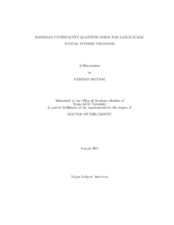| dc.contributor.advisor | Mallick, Bani K. | |
| dc.contributor.advisor | Efendiev, Yalchin | |
| dc.creator | Mondal, Anirban | |
| dc.date.accessioned | 2012-10-19T15:29:05Z | |
| dc.date.accessioned | 2012-10-22T18:04:06Z | |
| dc.date.available | 2012-10-19T15:29:05Z | |
| dc.date.available | 2012-10-22T18:04:06Z | |
| dc.date.created | 2011-08 | |
| dc.date.issued | 2012-10-19 | |
| dc.date.submitted | August 2011 | |
| dc.identifier.uri | https://hdl.handle.net/1969.1/ETD-TAMU-2011-08-9905 | |
| dc.description.abstract | We considered a Bayesian approach to nonlinear inverse problems in which the unknown quantity is a high dimension spatial field. The Bayesian approach contains a
natural mechanism for regularization in the form of prior information, can incorporate information from heterogeneous sources and provides a quantitative assessment of uncertainty in the inverse solution. The Bayesian setting casts the inverse solution as a posterior probability distribution over the model parameters. Karhunen-Lo'eve expansion and Discrete Cosine transform were used for dimension reduction of the
random spatial field. Furthermore, we used a hierarchical Bayes model to inject multiscale data in the modeling framework. In this Bayesian framework, we have shown that this inverse problem is well-posed by proving that the posterior measure is Lipschitz continuous with respect to the data in total variation norm. The need for multiple evaluations of the forward model on a high dimension spatial field (e.g. in the context of MCMC) together with the high dimensionality of the posterior, results in many computation challenges. We developed two-stage reversible jump MCMC method which has the ability to screen the bad proposals in the first inexpensive stage. Channelized spatial fields were represented by facies boundaries and
variogram-based spatial fields within each facies. Using level-set based approach, the shape of the channel boundaries was updated with dynamic data using a Bayesian
hierarchical model where the number of points representing the channel boundaries is assumed to be unknown. Statistical emulators on a large scale spatial field were introduced to avoid the expensive likelihood calculation, which contains the forward simulator, at each iteration of the MCMC step. To build the emulator, the original spatial field was represented by a low dimensional parameterization using Discrete Cosine Transform (DCT), then the Bayesian approach to multivariate adaptive regression spline (BMARS) was used to emulate the simulator. Various numerical results were presented by analyzing simulated as well as real data. | en |
| dc.format.mimetype | application/pdf | |
| dc.language.iso | en_US | |
| dc.subject | Bayesian Hierarchical Model | en |
| dc.subject | Karhunen Loeve Expansion | en |
| dc.subject | Two Stage Reversible Jump Markov Chain Monte Carlo | en |
| dc.subject | Discrete Cosine Transform | en |
| dc.subject | Emulator | en |
| dc.subject | Bayesian Multivariate Adaptive Regression Splines | en |
| dc.title | Bayesian Uncertainty Quantification for Large Scale Spatial Inverse Problems | en |
| dc.type | Thesis | en |
| thesis.degree.department | Statistics | en |
| thesis.degree.discipline | Statistics | en |
| thesis.degree.grantor | Texas A&M University | en |
| thesis.degree.name | Doctor of Philosophy | en |
| thesis.degree.level | Doctoral | en |
| dc.contributor.committeeMember | Liang, Faming | |
| dc.contributor.committeeMember | Datta-Gupta, Akhil | |
| dc.contributor.committeeMember | Sinha, Samiran | |
| dc.type.genre | thesis | en |
| dc.type.material | text | en |


